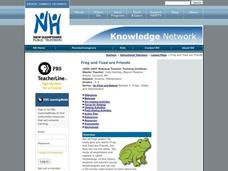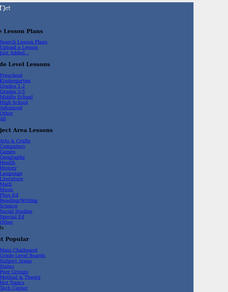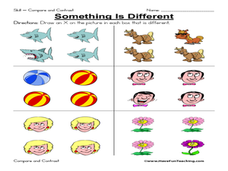Curated OER
Frog or Toad? How Can You Tell?
Young scholars compare and contrast frogs and toads. In groups, they research the life cycle of amphibians, their life cycles, breeding habits and ways they survive. Students list words or phrases describing their amphibian. After...
Curated OER
Frog and Toad are Friends
Students view a 30-minute video instructional activity to discover information about the characteristics of frogs and toads. They then transform themselves into frogs and participate in a Jumping Frog Jubilee. They work in groups of...
Curated OER
Frog and Toad Are Confusing
Third graders are introduced to the similiarties and differences between a frog and a toad. In groups, they compare and contrast them and identify distinguishing characteristics of each. They watch a video on the animals and answer...
National Science Teachers Association
Hop into Action
Young scientists find out what makes amphibians such unique and interesting animals in this simple life science lesson. After looking at pictures and discussing the characteristics of amphibians, learners complete a series of three Venn...
Curated OER
Frogs and Toads Are Different
Second graders identify the unique characteristics of frogs and toads. Through Internet research and reading the book Frog and Toad are Friends by Arnold Lobel, 2nd graders compare and contrast the two amphibians.
Curated OER
Frog Or Toad?
In this expository comprehension worksheet, students read a 1-page informational article about frogs and toads, answer short answer questions, and fill out a Venn diagram to compare the two amphibians.
Curated OER
Animals attributes
First graders analyze different animals in fiction and nonfiction stories. In this animal lesson plan, 1st graders choose an animal and read a fiction story with that animal as a character. They describe how the animal acted in the story...
Curated OER
Frog and Toad
Second graders use a Venn Diagram to compare and contrast buttons after listening to the story, A Lost Button.
Curated OER
Learning Activities: Magic Words
Students use poetry to compare and contrast humans and frogs.
Curated OER
Marshland Wonders
Students review the characteristics of wetlands and list their benefits. After viewing short videos, they identify the organims that make their home in wetlands and how they have adapted. They compare and contrast the characteristics...
Curated OER
Analyzing Character Traits
Young scholars read "Frog and Toad are Friends" and investigate physical, emotional, and mental character traits. They brainstorm a list of character traits that make a good friend. The list is placed into a visual ranking system that...
Curated OER
Investigation 12 - Amphibians & Reptiles
Fourth graders compare and contrast the behavior and structure of amphibians and reptiles of Utah. The Division of Wildlife Resources website is an important resource for them to access, for information as well as colorful pictures of...
Curated OER
Something is Different: Same/Different
In this different/same worksheet, student draw an X on the picture in a box that is different from the others, 6 sets total. A reference web site is given for additional activities.
Scholastic
Mixed Bags: Fiction and Nonfiction
Using a bag with one fiction and non-fiction book of similar topics, partners work together to find the differences and similarities of each story. They record their obervances in a T-chart.
Curated OER
A Moth Is Not a Butterfly!
Students identify the differences and similarities between a butterfly and a moth. They complete a Venn diagram, participate in class discussion and conduct related Internet research on the topic.
















